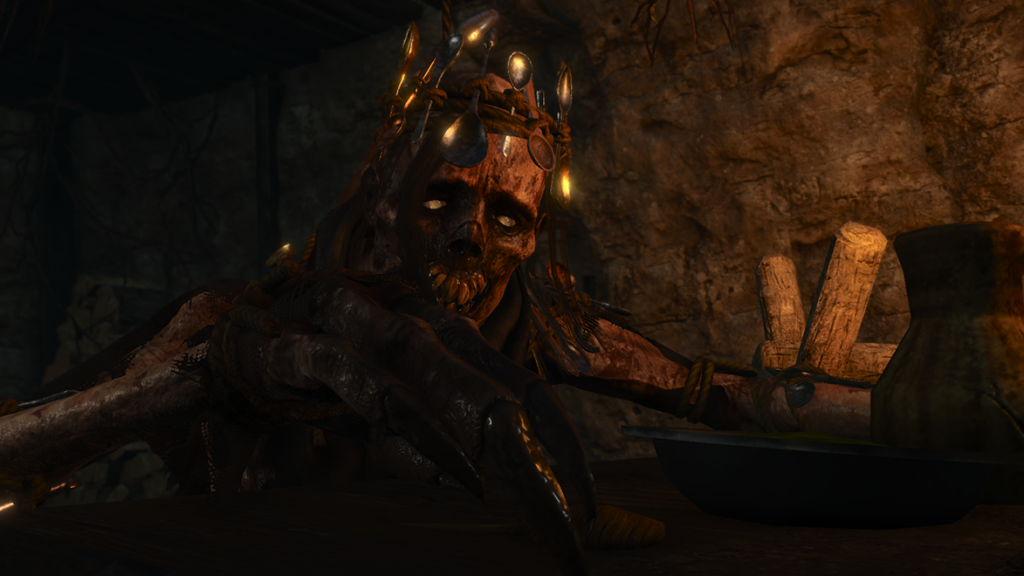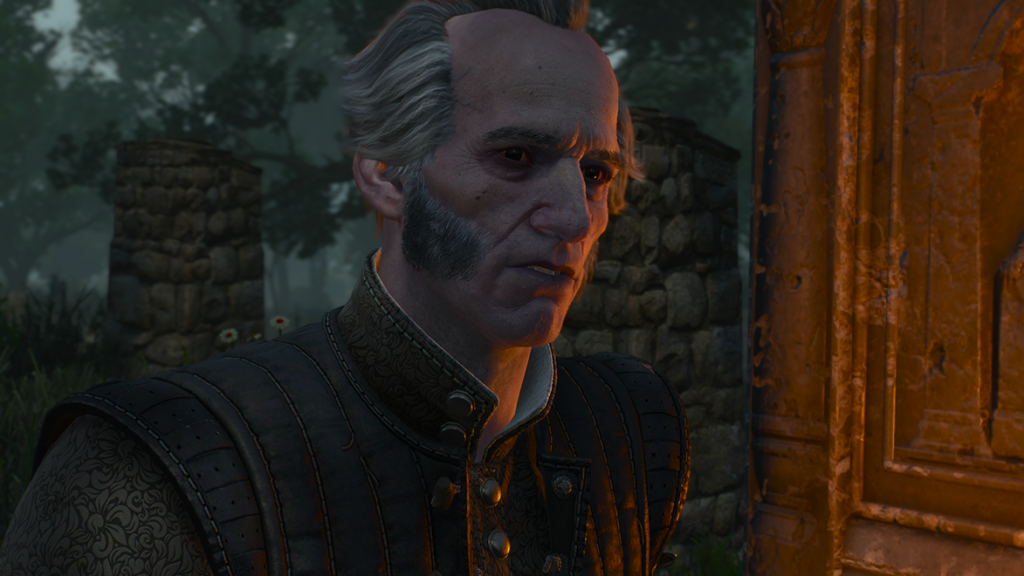“I like rusty spoons” whispers Salad Fingers, in his bizarre quavering voice, those ovular eyes pointed in precisely the opposite direction from each other. “I must find the perfect spoon.” Pleasingly creepy and unhinged, David Firth’s crudely-made web series appears, at this distance of a decade, as a fairly distinctive generational marker. That’s why it seems an unlikely coincidence when, in The Witcher 3: Blood and Wine, we find a creature with exactly the same desire. Holed away in a overgrown house is the Spoon Collector, a skeletal horror wracked by a supernatural curse that has it searching for the “perfect spoon” to sate its hunger. It is typical Witcher territory; a derelict home carefully populated with clues, journals and letters, leading to an inevitable encounter with a dangerous monster. The fact that among these clues are more than a few rusty spoons feels like it cements the Salad Fingers reference in place. But while this would seem to condemn the Spoon Collector to being little more than a joke, a silly reference in an expansion with a fair share of weird and frankly crappy jokes—including a character whose initials are “D.L.C.” and another whose name is “Barnabas-Basil Foulty”—this is a creature far more slippery than that.

As a spotted-wight, an emaciated, distorted breed of creature so terrifying that we are told they were hunted to extinction by the witchers long past, the Spoon Collector makes for an unpleasant sight. Tucked away in a wardrobe in a corner of its lair, Geralt watches as it stumbles around with an unpredictable gait, tending to its noxious cauldron. It’s a scene with some wonderfully old-fashioned horror-movie tension; the half glimpsed monstrosity watched as it goes about its dark deeds. But as the Spoon Collector approaches Geralt’s hiding place with madly roving eyes, the scene transforms. Here, we are given the chance to attack, or to try to lift the creature’s curse. Both choices lead to wonderfully bizarre events. Choose to attack and you’ll trigger a battle where the Spoon Collector swims through a pool of spoons like a cutlery-obsessed Scrooge McDuck. But attempt to lift the curse instead and Geralt has to sit down to dinner with the damn thing. Suddenly, the creature transforms from sinister to slapstick, as the Witcher tentatively guides the creature into sitting with him, like teaching a child to eat through imitation alone. Its also an oddly affectionate scene—not just between Geralt and the creature, but between developer CD Projekt RED and their subject matter. The Spoon Collector’s careful animations and expressions, its wobbling gait and comic timing all pointing to a loving level of craft and attention expended on the Spoon Collector, one that delights in the grotesque and fantastic potential of man-eating monsters.
///
The Witcher 3: Wild Hunt’s (2015) base game is filled to the brim with peasants. Stand still in one of its muddy, godforsaken villages and you can watch them mill around, gabbling on about the weather or their ailments, spouting aphorisms for the downtrodden: “Nothing hurts so much as life,” observes an abused servant. “Even the gods weep for our misfortune,” grumbles a rain-sodden farmer. “No such things as bad ships or bad weather,” croaks a wizened Skelliger, before adding: “only worthless fucking sailors.” It’s an atmosphere that falls somewhere between the silly humor of Monty Python and the Holy Grail (1975) and the deranged, mud-caked mutterings of Alexei German’s Hard to be a God (2014). Like German’s masterpiece it’s also hard to place these interjections on a scale that stretches from perverse to profound. This is what gives the game much of its rich character, especially in side quests and witcher contracts that have Geralt rubbing elbows with the underclass. Even the games more notable questline, the much-praised Bloody Baron, hinges on this atmosphere of medieval grubbiness. That’s why, when The Witcher 3: Blood and Wine takes us off to a fairytale kingdom of knights and nobles, complete with a Disney Cinderella Castle at its center, something feels missing. Unsurprisingly, the knights turn out to be asinine and vapid characters, their appearances usually involve them acting as likely foils to Geralt’s now well-worn snarky comments. Unfortunately, these exercises in gentle fun-poking have none of the grit and charm of Geralt’s dealings with bloody-minded peasant folk, and in the end, the expansion’s humans end up fading into the background. However, rather than losing its identity through this shift, Blood and Wine takes this opportunity to let its monsters take more of the spotlight.
The Spoon Collector is just one among many of these monsters. From the very start, Blood and Wine throws wonderful monster after wonderful monster at you in a run of tricky battles, including the Dark Souls-like giant Golyat and the ancient geological structures of the Shaelmaar. Each is elegantly animated, distinctively designed and carefully back-storied. Together they are a strong reminder that monsters are the true heart of the Witcher series. However, while these beasts are fearsome enemies and strong works of design, their memorable nature stems from CD Projekt RED’s pursuit of sympathy for these creatures. The gigantic Golyat, according to a legend found in the game world, is actually Luis Alberni, a knight punished for his vanity by the Lady of the Lake by being transformed into a misshapen giant. Meanwhile the Shaelmaar, a rare and powerful creature from deep within the earth, is simply being used for entertainment in the Duchess’s tournament ring, its sensitive hearing tormented by the roar of the crowd. Again and again the player is given reasons to be sympathetic towards these creatures, to find explanations for their actions, pity for their fates. In short, the monsters of The Witcher 3: Blood and Wine are not beasts, but characters, even if they might not speak a word.

This attitude is part of a long tradition of finding the human in monsters, perhaps most recently and compellingly pursued by director Guillermo del Toro. From the ghosts of The Devil’s Backbone (2001) and the faun of Pan’s Labyrinth (2006), to the ensemble cast of freaks and creatures in the Hellboy films, Del Toro finds his strongest characters in the supernatural, the lost and the monstrous. Combined with his precise eye for strong design and love of practical effects (perhaps best evidenced in Hellboy 2’s wonderful Troll Market) Del Toro’s monsters are built for more than just mass slaughter or jump scares—they are explorations of his own sense of identity, his own love of the macabre. Del Toro has often said that his vision of Hellboy, a character much like the witcher Geralt, trapped between the worlds of monsters and men, is his most personal work. That might seem strange for a such a pulp film series, but Del Toro sees Hellboy as “a monument to human vulnerability.” And perhaps it is this vulnerability that makes his monsters so compelling, even when they are simultaneously terrifying. In a comprehensive interview in 2011 with the New York Times, Del Toro said “I’m not just Hellboy—I’m the Pale Man, too.” The Pale Man, the eyeless child-murder of Pan’s Labyrinth, and one of contemporary cinema’s greatest monsters, is not the first creature you would think of as relatable. But for Del Toro this creature was an image of pure and primitive greed, stemming from his own struggle with his weight. The Pale Man, in Del Toro’s eyes, was not just another cool idea for a freakish beast, but an expression of something undeniably, even unpleasantly, human.
///
I don’t want to spoil the fate of the Spoon Collector, but there is something of the Pale Man in its nature. This creature too is formed of a very human failing, and finds its cure in the most positive human aspect of Geralt, his compassion. This compassion is something that, if the player chooses, they can show to many of the creatures of Blood and Wine. In fact, while there are irredeemable horrors in its bestiary—corpse-eaters and child-killers, creatures from nightmares and fever-dreams—Blood and Wine finds its strongest moments in its discussions of humanity through the lens of monsters. Emiel Regis Rohellec Terzieff-Godefroy, or Regis for short, plays a large part in these discussions. A higher vampire who no longer drinks the blood of the living, and an old friend of Geralt, Regis’ softly-spoken manner and composed attitude betray a fierce intelligence. Voiced in what is a rare understated performance by Mark Nobel, Regis brings discussions of the value of humanity to the fore, his immortal nature and powerful abilities making him unable to fully comprehend the short and ugly lives of humans. He is compassionate to a fault, loyal and intelligent, and yet he is by definition a monster. His presence among the oversaturated colors and more luridly bizarre quests of Blood and Wine is a pleasant one, shifting the expansion’s focus towards Geralt’s distance from the humans he seeks to protect, and his similarities to the beasts he slays.

This concern of The Witcher 3: Blood and Wine creates an interesting relationship to the themes and strengths of the base game. It suggests that the strength of the Witcher series neither lies in its fantastic monsters nor its richly drawn peasants, but somewhere between. It finds the monstrous, the ugly, and the grotesque in humans, and the redeemable, expressive elements of monsters, and in doing so it bridges the gap between them. However, rather than using this idea to damn both sides, it finds sympathy for its subjects. That sympathy can just as easily be for the terrifying Spoon Collector and its victims or the Bloody Baron and his abusive acts as both a father and husband. And it is that sympathy that opens us to the strongest message of The Witcher 3 games, that like it or not, humans and monsters are closer than we could ever imagine.
